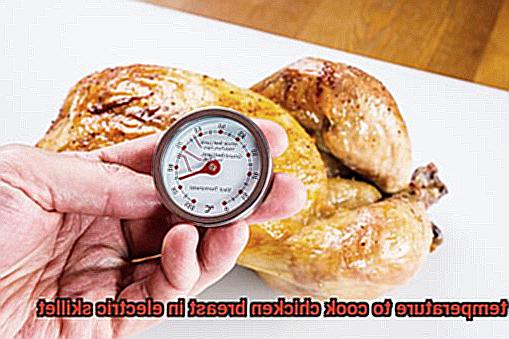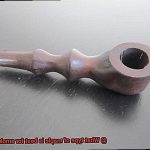Do you dread cooking chicken breast in an electric skillet, only to end up with a dry and tasteless dish? Fear not. As an expert on the subject, I’m here to share with you the perfect temperature for cooking your chicken breast in an electric skillet. Whether you’re a seasoned chef or a beginner cook, nailing the perfect chicken breast can be challenging. But with my tips and tricks, you’ll be able to impress your loved ones with juicy and flavorful chicken every time.
Electric skillets are a versatile tool for cooking, especially when it comes to chicken breast. However, the temperature at which you cook your poultry is crucial in determining its outcome. Cooking at too high of a temperature may result in overcooked and dry meat, while cooking at too low of a temperature can leave it undercooked and unsafe to eat.
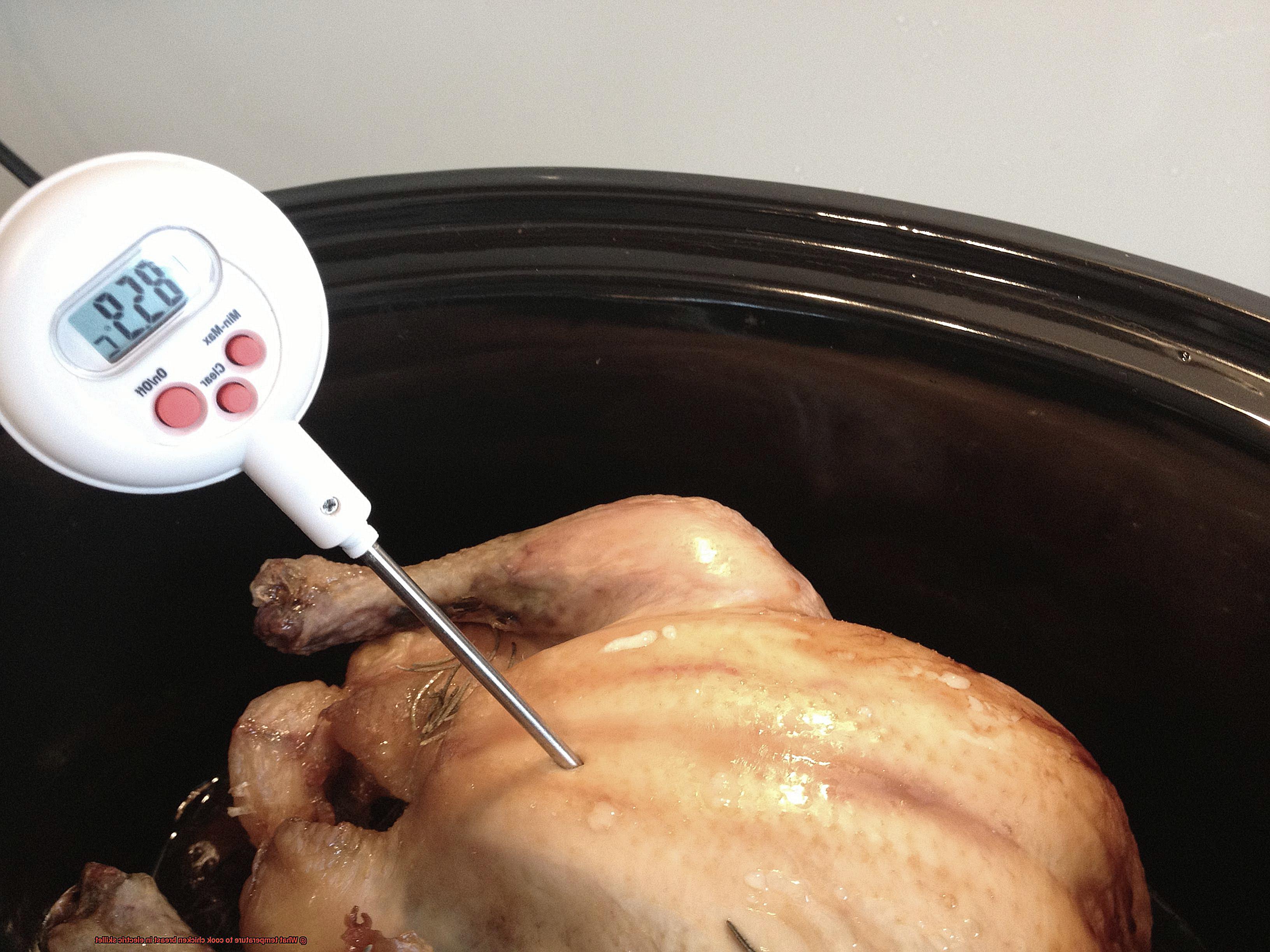
So how do you achieve the optimal temperature for your chicken? In this guide, I’ll walk you through the ideal temperature range for cooking chicken breast in an electric skillet. Plus, I’ll provide some useful tips on achieving tender and succulent meat that will have your taste buds dancing with joy. Get ready to elevate your chicken game.
Contents
What Temperature to Cook Chicken Breast in Electric Skillet
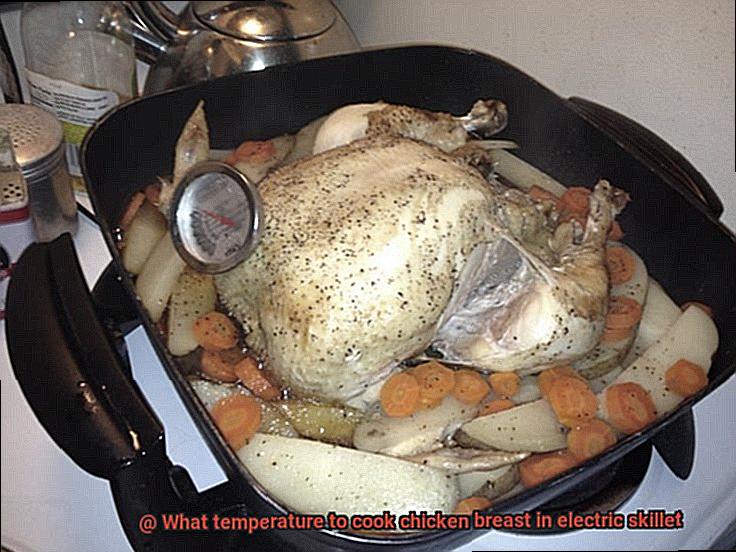
Before you start cooking, it’s crucial to understand the ideal temperature range to ensure your chicken is cooked thoroughly and safely.
To cook chicken breast in an electric skillet, 165°F (74°C) is the recommended internal temperature. This temperature not only ensures that the chicken is fully cooked, but also eliminates any harmful bacteria that may be present. The beauty of an electric skillet is its ability to provide consistent heat, making it easier to maintain a steady cooking temperature throughout the process.
To achieve this ideal temperature, preheat your electric skillet to 375°F (191°C) before adding your chicken breasts. This ensures that your chicken cooks evenly and consistently. Don’t forget to use a meat thermometer to monitor the internal temperature of the meat, taking care not to touch the bone or the bottom of the skillet. Once the internal temperature reaches 165°F (74°C), remove the chicken from the skillet and allow it to rest for a few minutes before serving.
It’s important to note that thicker cuts of chicken may require a lower temperature and longer cooking time. Keep this in mind as you prepare your meal.
Also, be mindful of any sweet marinades or seasonings that may cause burning at high temperatures. If using a sweet or sugary marinade, apply it towards the end of the cooking process or use it sparingly.
Factors to Consider When Cooking Chicken Breast in an Electric Skillet
When it comes to cooking chicken breast in an electric skillet, there are several factors to consider that can impact the taste and texture of your dish. As an expert on this topic, let me guide you through the key things to keep in mind.
Firstly, the temperature of your skillet is crucial. To ensure food safety, it’s essential that the chicken reaches an internal temperature of 165°F (74°C). Preheat your skillet to around 375°F (191°C) before adding the chicken to help cook it evenly and thoroughly. Using a meat thermometer can also help you check the internal temperature of your chicken and avoid undercooking or overcooking.
Another factor to consider is the thickness of your chicken breast. Thicker pieces will require longer cooking times than thinner ones. Adjust your cooking time accordingly or use a meat tenderizer to flatten thicker pieces if necessary. This will help prevent uneven cooking and ensure that your chicken is cooked all the way through.
The type of electric skillet you’re using can also make a difference in how well your chicken cooks. Non-stick skillets tend to heat up more quickly and evenly than cast iron skillets, for example. So, choose the right skillet for your needs based on how you like your chicken cooked. It’s also essential to regularly clean your electric skillet as buildup can affect its performance over time.
Seasoning is another crucial factor when it comes to cooking chicken breast in an electric skillet. Proper seasoning can greatly impact the final flavor of your dish. Some popular seasoning options for chicken breast include garlic powder, paprika, and thyme. Experiment with different spices and herbs, but be careful not to use anything too sweet as it may cause burning.

Finally, don’t forget to let your cooked chicken rest for a few minutes before slicing or serving. This allows the juices to redistribute throughout the meat and results in a juicier and more flavorful final product. Cover your cooked chicken with foil to keep it warm while it rests.
The Recommended Temperature for Cooking Chicken Breast
Firstly, the temperature range of 350°F to 375°F (175°C to 190°C) is the sweet spot for cooking chicken breast in an electric skillet. This temperature range allows the chicken to cook evenly without burning on the outside. Preheat your electric skillet before adding the chicken to ensure it reaches the desired temperature.
Secondly, keep in mind that cooking times will vary depending on the thickness of the chicken breast. For boneless chicken breast, cook for around 6-8 minutes per side. For bone-in chicken breast, it may take up to 10-12 minutes per side. Use a meat thermometer to ensure that the internal temperature of the chicken reaches 165°F (74°C) before serving.
In addition, seasoning your chicken beforehand is essential for added flavor. Salt, pepper, and any other desired herbs or spices can be used. You can also marinate your chicken beforehand to infuse it with even more flavor. The possibilities are endless.
The Thickness of the Chicken Breast Affects Cooking Time and Temperature
Let’s explore the fascinating world of chicken breasts and how the thickness affects cooking time and temperature in an electric skillet.
Firstly, the thickness of the chicken breast is a crucial factor that affects cooking time and temperature. Thicker chicken breasts require lower temperatures and longer cooking times as the heat must penetrate through the meat to cook it evenly. If you cook a thicker chicken breast at too high a temperature, the outside may burn while the inside remains undercooked.
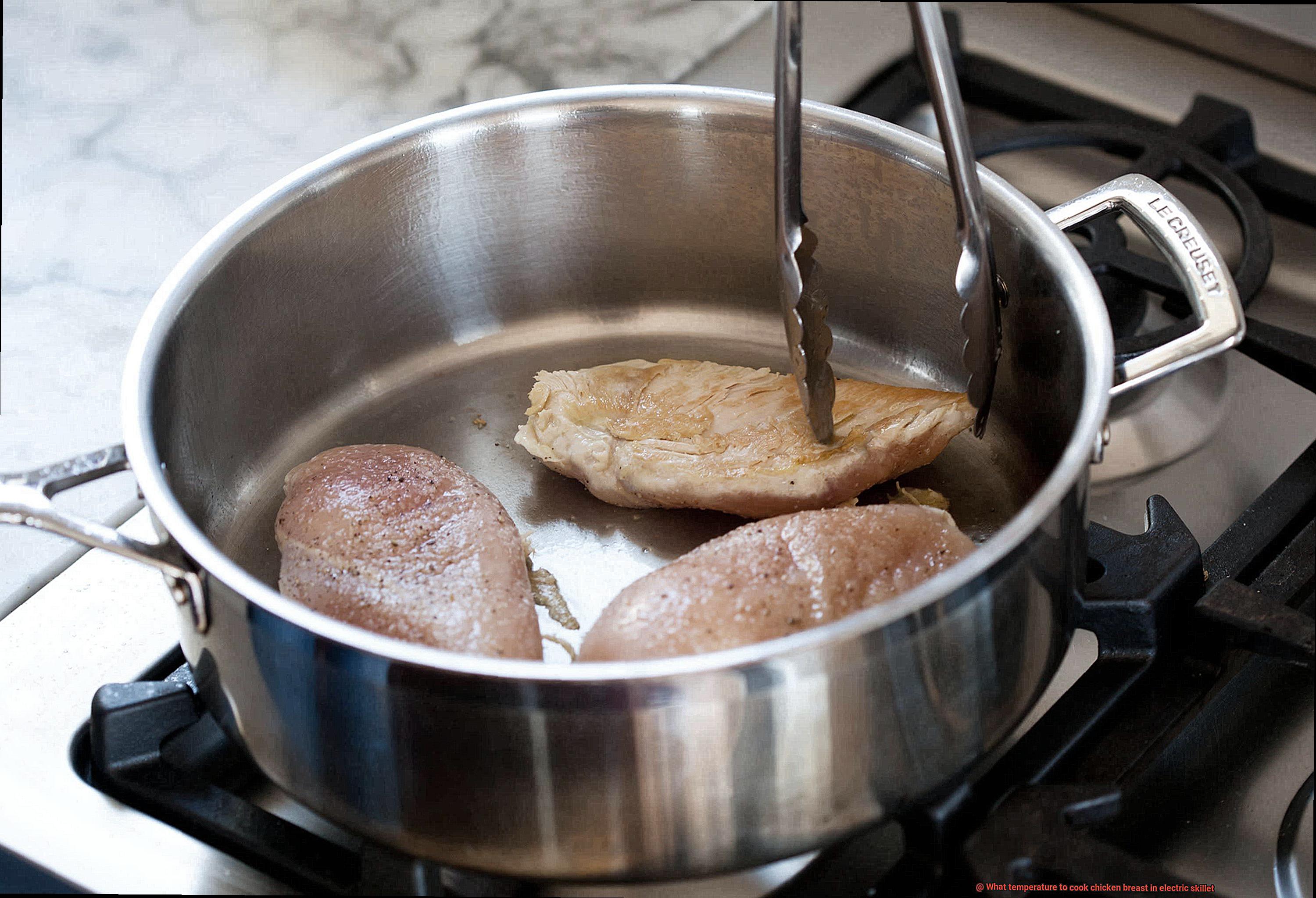
To avoid this problem, using a meat thermometer is essential. Insert it into the thickest part of the meat, without touching any bones, and check the internal temperature. The USDA recommends cooking chicken breasts to an internal temperature of 165°F (74°C) to eliminate any potentially harmful bacteria. This is especially important when cooking thicker cuts of meat that may take longer to reach this temperature.
Now that we have covered the basics let’s delve into cooking times and temperatures. A 1-inch thick chicken breast generally requires 6-8 minutes per side at medium-high heat (around 375°F or 190°C). However, it is vital to adjust the cooking time and temperature based on the thickness of your specific chicken breast.
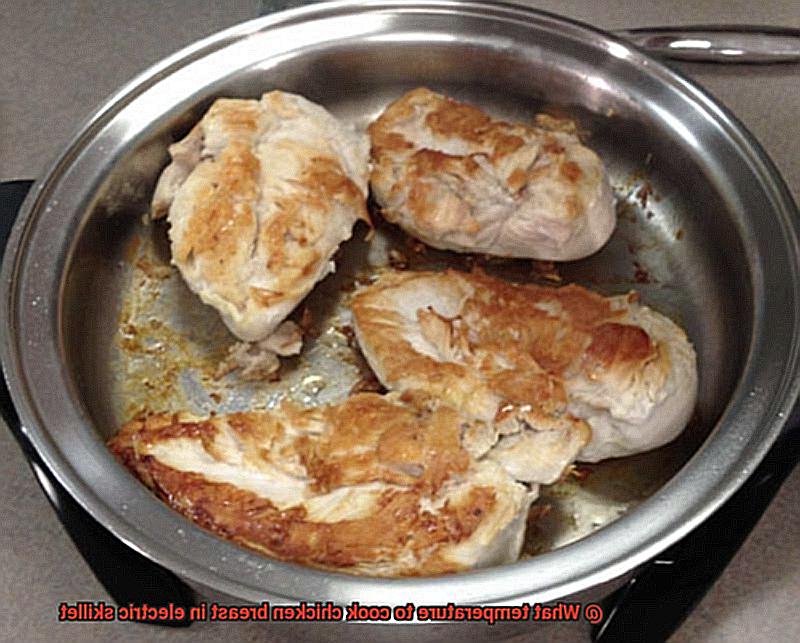
To sum up, here are some sub-topics to keep in mind when preparing chicken breasts in an electric skillet:
- Thickness is everything: Thicker chicken breasts require lower temperatures and longer cooking times.
- Use a meat thermometer: Check the internal temperature of your chicken breast to ensure it has reached 165°F (74°C).
- Adjust cooking time and temperature: Start with medium-high heat (around 375°F or 190°C) and cook for 6-8 minutes per side for a 1-inch thick piece of meat, but adjust based on the thickness of your specific chicken breast.
Checking the Internal Temperature of the Chicken
Cooking chicken breast in an electric skillet is a great way to prepare a delicious meal quickly and easily, but ensuring that the chicken is cooked properly is crucial. This is where checking the internal temperature comes in. As an expert on this matter, I am here to help you navigate the process and provide you with some useful tips and tricks.
The USDA recommends that cooked chicken’s internal temperature should be 165°F (74°C) to make sure that all harmful bacteria are killed, making it safe for consumption. So, how do we achieve this?
The best way to check the internal temperature of your chicken breast is by using a meat thermometer. To do this, insert the thermometer into the thickest part of the meat without touching any bones or the bottom of the skillet. Wait for a few seconds until the temperature stabilizes before reading it. If it reads below 165°F (74°C), continue cooking until it reaches the recommended temperature.
It’s important to note that you should not rely solely on color or juices running clear as an indicator of doneness, as these can be misleading. Using a meat thermometer eliminates any guesswork and assures that your chicken is cooked through and safe to eat.
Another vital factor to consider when cooking chicken is cross-contamination. If you’re using a marinade or basting sauce on your chicken, make sure to discard any unused portion as it may be contaminated with raw chicken juices. Also, always properly clean and sanitize any utensils or surfaces that come into contact with raw chicken.
Using Sweet Marinades or Seasonings Sparingly
While sweet marinades and seasonings can add a delicious flavor to your dish, it’s important to use them sparingly and with care. Here are some tips to ensure that your chicken is not overly sweet or burnt:
- Use no more than 1-2 tablespoons of marinade per pound of chicken. This will ensure that the flavor is present without being overwhelming.
- Apply your sweet marinade or seasoning towards the end of the cooking process to avoid burning and overly sweet chicken. Brush it onto the chicken during the last few minutes of cooking or sprinkle it over the chicken just before removing it from the skillet.
- Choose your marinade or seasoning wisely to avoid high sugar content that can lead to burning and overly sweet chicken. Be sure to read the label and choose a marinade or seasoning with a lower sugar content.
- Balance out your sweet marinades or seasonings with acidic ingredients like lemon juice or vinegar. This will help cut through the sweetness and add a nice tangy flavor to your chicken.
Tips for Ensuring that the Chicken is Cooked at the Right Temperature
Achieving perfectly cooked and juicy chicken in an electric skillet is possible with the right techniques. Follow these tips to ensure that your chicken is cooked at the right temperature:
Use a meat thermometer
To ensure that your chicken is cooked thoroughly and safely, use a meat thermometer to check its internal temperature. The minimum safe internal temperature for chicken is 165°F (74°C). Insert the thermometer into the thickest part of the chicken breast to get an accurate reading.
Preheat the skillet
Preheating your electric skillet is crucial to achieving even cooking and preventing the chicken from sticking to the pan. Let the skillet heat up before adding the chicken, so it starts cooking immediately at the right temperature.
Adjust the temperature as needed
Depending on your electric skillet’s strength, adjust the temperature during cooking to ensure that the chicken cooks evenly and thoroughly. If you notice that some pieces are cooking too quickly or too slowly, adjust the temperature accordingly to achieve perfectly cooked chicken.
Don’t overcrowd the skillet
Overcrowding your skillet can cause uneven cooking and may leave some pieces undercooked. Make sure there is enough space between each piece of chicken so that they cook evenly and thoroughly.
Let it rest
Once your chicken has reached the appropriate internal temperature, let it rest for a few minutes before slicing into it. This allows the juices to redistribute throughout the meat, making it more tender and flavorful.
7gjhBm_yLsM” >
Conclusion
In summary, cooking chicken breast in an electric skillet can be a daunting task, but with the right temperature and techniques, you can achieve mouth-watering meat that is sure to impress. To ensure that your chicken is safe to eat, it’s important to cook it to an internal temperature of 165°F (74°C). This can be achieved by preheating your electric skillet to around 375°F (191°C) before adding your chicken breasts.
When cooking chicken breast in an electric skillet, there are other factors to consider besides temperature. For example, using too much seasoning or sweet marinades can lead to burnt or overly sweet chicken. To avoid this, use seasonings sparingly and monitor the internal temperature of the meat with a meat thermometer.
It’s also important to keep cross-contamination in mind when handling raw chicken. Always wash your hands and any utensils that come into contact with raw chicken thoroughly before using them again.
By following these tips and experimenting with different spices and herbs, you’ll be able to create perfectly cooked and flavorful chicken every time.

